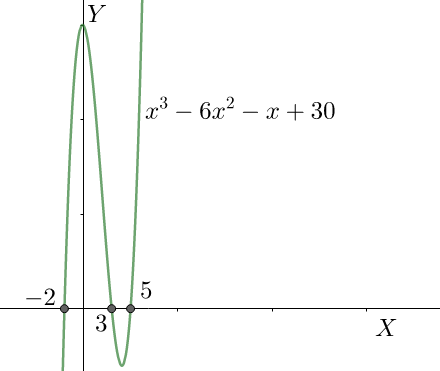
How do you factor ${{x}^{3}}-6{{x}^{2}}-x+30$ ?
Answer
531.3k+ views
Hint: For this expression, we put different values of $x$ by hit and trial method in the expression and check which value of $x$ makes the expression equal to zero. Suppose that value is $3$ . So, $x-3$ is a factor and dividing the expression by $x-3$ gives other factors.
Complete step by step solution:The given expression is,
${{x}^{3}}-6{{x}^{2}}-x+30$
We now put some natural numbers one by one in the above expression and see if the expression evaluates to zero or not. If the expression evaluates to zero, then that value of $x$ is the root of the expression and if it does not evaluate to zero, then it Is not a root. Let us put $x=1$ first. Doing so, the expression becomes,
$\begin{align}
& \Rightarrow {{1}^{3}}-6{{\left( 1 \right)}^{2}}-1+30 \\
& \Rightarrow 24 \\
\end{align}$
Thus, $x=1$ does not satisfy the expression. So, we now put $x=2$ . Doing so, the expression becomes,
$\begin{align}
& \Rightarrow {{2}^{3}}-6{{\left( 2 \right)}^{2}}-2+30 \\
& \Rightarrow 12 \\
\end{align}$
Thus, $x=1$ does not satisfy the expression. So, we now put $x=2$ . Doing so, the expression becomes,
$\begin{align}
& \Rightarrow {{3}^{3}}-6{{\left( 3 \right)}^{2}}-3+30 \\
& \Rightarrow 0 \\
\end{align}$
This means that $x=3$ is a root of the expression or that $x-3$ is a factor of it. We now divide ${{x}^{3}}-6{{x}^{2}}-x+30$ by $x-3$ . We get ${{x}^{2}}-3x-10$ as quotient. This means,
${{x}^{3}}-6{{x}^{2}}-x+30=\left( x-3 \right)\left( {{x}^{2}}-3x-10 \right)$
We now factorise ${{x}^{2}}-3x-10$ . If we put $x=-2$ in this expression, we get,
$\Rightarrow {{\left( -2 \right)}^{2}}-3\left( -2 \right)-10=0$
This means that $x=-2$ is a root of the expression ${{x}^{2}}-3x-10$ or that $x+2$ is a factor of ${{x}^{2}}-3x-10$ . Dividing ${{x}^{2}}-3x-10$ by $x+2$ , we get, $x-5$ as quotient . Thus, ${{x}^{2}}-3x-10$ can be written as,
$\Rightarrow {{x}^{2}}-3x-10=\left( x+2 \right)\left( x-5 \right)$
Thus, summing up every expression we get, we can write that,
$\Rightarrow {{x}^{3}}-6{{x}^{2}}-x+30=\left( x-3 \right)\left( x+2 \right)\left( x-5 \right)$
Therefore we can conclude that the given expression can be factorised as $\left( x-3 \right)\left( x+2 \right)\left( x-5 \right)$ .
Note: We should be careful while putting the values and evaluating the expression. We should take care of the signs as students make mistakes here. This problem can also be solved graphically by plotting the graph and seeing at which values of $x$ , the graph cuts the $x-axis$ . These will be the roots and the corresponding $x-\left( value \right)$ will be the factors.

Complete step by step solution:The given expression is,
${{x}^{3}}-6{{x}^{2}}-x+30$
We now put some natural numbers one by one in the above expression and see if the expression evaluates to zero or not. If the expression evaluates to zero, then that value of $x$ is the root of the expression and if it does not evaluate to zero, then it Is not a root. Let us put $x=1$ first. Doing so, the expression becomes,
$\begin{align}
& \Rightarrow {{1}^{3}}-6{{\left( 1 \right)}^{2}}-1+30 \\
& \Rightarrow 24 \\
\end{align}$
Thus, $x=1$ does not satisfy the expression. So, we now put $x=2$ . Doing so, the expression becomes,
$\begin{align}
& \Rightarrow {{2}^{3}}-6{{\left( 2 \right)}^{2}}-2+30 \\
& \Rightarrow 12 \\
\end{align}$
Thus, $x=1$ does not satisfy the expression. So, we now put $x=2$ . Doing so, the expression becomes,
$\begin{align}
& \Rightarrow {{3}^{3}}-6{{\left( 3 \right)}^{2}}-3+30 \\
& \Rightarrow 0 \\
\end{align}$
This means that $x=3$ is a root of the expression or that $x-3$ is a factor of it. We now divide ${{x}^{3}}-6{{x}^{2}}-x+30$ by $x-3$ . We get ${{x}^{2}}-3x-10$ as quotient. This means,
${{x}^{3}}-6{{x}^{2}}-x+30=\left( x-3 \right)\left( {{x}^{2}}-3x-10 \right)$
We now factorise ${{x}^{2}}-3x-10$ . If we put $x=-2$ in this expression, we get,
$\Rightarrow {{\left( -2 \right)}^{2}}-3\left( -2 \right)-10=0$
This means that $x=-2$ is a root of the expression ${{x}^{2}}-3x-10$ or that $x+2$ is a factor of ${{x}^{2}}-3x-10$ . Dividing ${{x}^{2}}-3x-10$ by $x+2$ , we get, $x-5$ as quotient . Thus, ${{x}^{2}}-3x-10$ can be written as,
$\Rightarrow {{x}^{2}}-3x-10=\left( x+2 \right)\left( x-5 \right)$
Thus, summing up every expression we get, we can write that,
$\Rightarrow {{x}^{3}}-6{{x}^{2}}-x+30=\left( x-3 \right)\left( x+2 \right)\left( x-5 \right)$
Therefore we can conclude that the given expression can be factorised as $\left( x-3 \right)\left( x+2 \right)\left( x-5 \right)$ .
Note: We should be careful while putting the values and evaluating the expression. We should take care of the signs as students make mistakes here. This problem can also be solved graphically by plotting the graph and seeing at which values of $x$ , the graph cuts the $x-axis$ . These will be the roots and the corresponding $x-\left( value \right)$ will be the factors.

Recently Updated Pages
Master Class 10 General Knowledge: Engaging Questions & Answers for Success

Master Class 10 Computer Science: Engaging Questions & Answers for Success

Master Class 10 English: Engaging Questions & Answers for Success

Master Class 10 Social Science: Engaging Questions & Answers for Success

Master Class 10 Maths: Engaging Questions & Answers for Success

Master Class 10 Science: Engaging Questions & Answers for Success

Trending doubts
The shortest day of the year in India

Why is there a time difference of about 5 hours between class 10 social science CBSE

Write a letter to the principal requesting him to grant class 10 english CBSE

What is the median of the first 10 natural numbers class 10 maths CBSE

The Equation xxx + 2 is Satisfied when x is Equal to Class 10 Maths

State and prove converse of BPT Basic Proportionality class 10 maths CBSE




